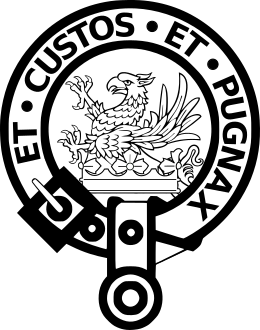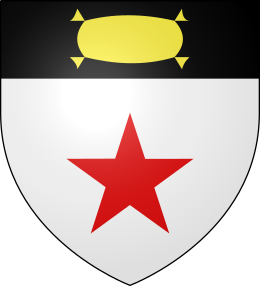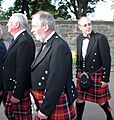Clan Marjoribanks facts for kids
Quick facts for kids Clan Marjoribanks |
|||
|---|---|---|---|

Crest: A demi-griffin Proper, issuant from a crest coronet Or
|
|||
| Motto | ET CUSTOS ET PUGNAX | ||
| Profile | |||
| Region | Lowlands | ||
| District | Renfrewshire | ||
| Chief | |||
 |
|||
| Andrew George Marjoribanks of that Ilk | |||
| Chief of the Name and Arms of Marjoribanks | |||
| Historic seat | Balbardie House | ||
|
|||
The Clan Marjoribanks is a historic Scottish clan. It comes from the Scottish Lowlands area of Scotland. A clan is a group of families linked by a common ancestor or a shared name.
Contents
History of the Marjoribanks Clan
Where Did the Name Marjoribanks Come From?
Many people believe the name Marjoribanks comes from Marjorie Bruce. She was the daughter of King Robert the Bruce. The story says she received lands called "Marjorie's Banks" when she married in 1315. However, this story is not true. Marjorie's dowry did not include such lands.
Another idea is that lands near Ratho were given to an early Marjoribanks in the 1500s. These lands did belong to Marjorie. But the Marjoribanks name was already in use 50 years before this.
The first known person with the name was Philip "de Merioribankis de eodem." He appeared in records in 1485. He owned lands called "Merioribankis." These lands are now Marchbank Farm in Dumfriesshire. Philip was likely a member of the Johnstone family. He took the name Marjoribanks to show he was different from other Johnstones.
The name is usually said as 'Marchbanks'. Some historians think the Marjoribanks family was related to the Johnstone Lords of Annandale. They see clues in the Marjoribanks coat of arms. It has a gold cushion and a star. The Clan Johnstone's coat of arms has three gold cushions. A star in heraldry can mean a spur-rowel, which is on the Annandale Lord's crest (heraldry).
Important People in the 1500s
The Marjoribanks family became well-known in the early 1500s. This was when the Court of Session was restarted in Scotland. This court handles civil law cases.
Thomas Marjoribanks of that Ilk was the son of Philip Marjoribanks. In 1532, he became one of ten lawyers chosen to work for the court. These lawyers were called procurators.
In 1535, Thomas was named the lawyer "for the puir" (for the poor). He worked for free, refusing his salary. Because he was so public-spirited, he became Lord Provost of Edinburgh in 1540. This meant he was like the mayor of the city. He also represented Edinburgh in the Scottish Parliament in 1540 and 1546.
Thomas bought land at Ratho near Edinburgh in 1539. Ten years later, he became a judge and took the title 'Lord Ratho'. He also became the Lord Clerk Register. This was an important job in the Scottish government. He bought more land in Spotts and Annandale, Dumfries and Galloway.
From the 1600s to the 1700s
After Lord Ratho passed away, his grandson Thomas became the chief. In 1614, Thomas sold the Ratho lands. The family then bought lands at Balbardie around 1624.
Christian Marjoribanks was Lord Ratho's great-grandniece. She married George Heriot. He was a goldsmith and helped King James VI of Scotland with money. George Heriot founded the famous George Heriot's School in Edinburgh. He was very rich. People in Edinburgh called him 'Jinglin' Geordie' because he always had gold coins.
Andrew Marjoribanks of Balbardie was another important lawyer. He was appointed Writer to the King in 1716. He also worked as an agent for James Sandilands, 7th Lord Torphichen. Andrew was the commissary of Edinburgh. This was a key role in managing the property of people who had died.
From the 1800s to Today
Andrew Marjoribanks' grandson, Alexander, brought the family's story full circle. He bought the Barony of Bathgate. This land had also been part of Princess Marjorie's dowry.
Alexander was a leader in Linlithgowshire (now West Lothian) for over 30 years. In 1824, he gave up his baronial rights. This allowed Bathgate to become a burgh, which is like a town. Alexander became its first Provost.
His seventh son, the Reverend Thomas Marjoribanks, became the next chief. He was a minister in Lochmaben and later in Stenton. In 1861, he sold the Balbardie estates, including Balbardie House. These were sold to the people who managed Stewart's Hospital.
Thomas's eldest son, Alexander, became chief in 1869. He had no children, so his brother, the Reverend George Marjoribanks, became chief. George's son, the Reverend Thomas Marjoribanks, was the next chief. His son, another Reverend George Marjoribanks, became chief in 1947. This George Marjoribanks worked for the Moral Re-Armament spiritual movement. He died in 1955 without children.
The next chief was William Marjoribanks of that Ilk. He was George's brother and the father of the current chief. William was an ecologist. He worked on big conservation projects for the government of Sudan.
William's brother was Sir James Marjoribanks. He was a diplomat. He was the Ambassador to the European Economic Community when Britain was trying to join.
Other Branches of the Marjoribanks Family
A man named George Marjoribanks fought in the Jacobite rising of 1715. He was captured and sent to Virginia in 1716. Many of his family members now live in the US, especially in North and South Carolina. They have regular family meetings there.
A younger part of the family is called Marjoribanks of Lees. This line comes from James Marjoribanks. He was a younger son of Thomas Marjoribanks of Ratho. Another ancestor was Joseph Marjoribanks, a merchant in Edinburgh.
Joseph's son, John Marjoribanks, registered the family's coat of arms in 1673. A hundred years later, Edward Marjoribanks of Lees, a wine merchant, re-registered the arms. His son, Sir John Marjoribanks, 1st Baronet, became Lord Provost of Edinburgh and a baronet. His grandson David became Baron Marjoribanks. Another grandson, Dudley Coutts Marjoribanks, 1st Baron Tweedmouth, also became a baron. These titles no longer exist, but many descendants of the Marjoribanks of Lees live in England and the Channel Islands today.
Robert Marjoribanks was an engineer from Kirkpatrick-Juxta, Scotland. His two sons, Robert Alexander and John Walker Marjoribanks, moved to Newcastle, New South Wales, Australia. Many Marjoribanks descendants live there now. This includes Robert Marjoribanks, also known as "Bob Banks", who was an Australian rugby league player.
Marjoribanks Tartan
The Marjoribanks family has its own official tartan.
See also
- Scottish clan
- Marjoribanks Baronets
Images for kids
-
Map of Scotland showing Renfrewshire, where the Marjoribanks lived





